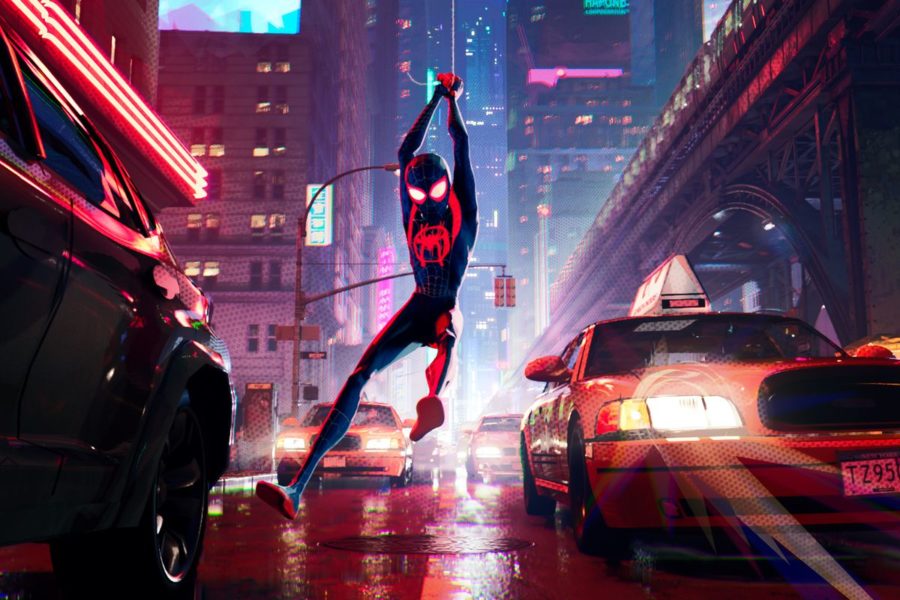“Spider-Man: Into the Spiderverse” is an explosion in every application of the word.
The newest spidey film, produced by Columbia Pictures and Sony Pictures Animation in association with Marvel, burst into theaters on Dec. 13, and the movie has since raked in $12.6 million as of Friday, Dec. 14. Estimations predict that the figure will reach $36 million by the end of opening weekend.
It received a 100 percent on Rotten Tomatoes in late November (and has since dropped to 97 percent as of Dec. 15 — still an impressive figure). Online movie critics and reviewers have also given it praise-laden reviews in admiration of the unique style and fun-loving atmosphere within the movie.
To add some context to the promising monetary analyses and stellar online reviews posted across internet servers, “Spider-Man: Into the Spiderverse” brings the audience exactly where it wants, exactly when it wants them there.
The film spins the origin story of Miles Morales (Shameik Moore), an Afro-Latino 15-year-old attending high school in Brooklyn, New York. In typical spider-person fashion, Morales is bitten by a radioactive spider and gains superhuman abilities — super strength, the ability to adhere to surfaces, turning invisible, and channeling powerful bursts of energy. (I’m not completely sure why channeling bursts of energy is spider-related, but I suppose that’s neither here nor there.)
“Into the Spiderverse” is funny, charming, and poignant, somehow all at once. Comedic elements are put to great effect through strategic animation cuts, and yet the movie still manages to maintain seriousness and meaning in its most emotionally-charged moments.
The key webbing together all of the amazing components of this movie is the visual effects and animation.
The visuals early on, pre-spider-bite, are the standard 2-D animation with slight comic-esque overtones and shading mixed in. However, when Miles wakes up with his new superpowers, the animation quickly follows suit with the rising plot of the movie.
The movie lays on the comic-book-inspired animation thick, popping in text boxes of Morales’ inner monologue and marring the already vibrant color scheme with spasms of disjunct colors. It’s apt parallelism, really, how the shift from Morales’ old life to his new one is matched by the animation’s transition from typical 2-D animation to more complex styles.
And oh, how the movie gets more complex.
“Into the Spiderverse” depicts a multiverse comprised mainly of five separate dimensions that converge around Morales’ reality. Peter Benjamin Parker (Jake Johnson), Gwen Stacey (Hailee Steinfeld), Spider Noir (Nicolas Cage), Peni Parker (Kimiko Glenn), and Spider-Ham (John Mulaney) are all brought into the fold for Morales to befriend and learn from.
(As a side note, the cast lineup for “Into the Spiderverse” is a marvel in and of itself. Whoever looked at Spider-Ham and thought, “yeah, let’s get John Mulaney in here,” is a genius and is doing everything correctly.)
The six spider-people (and, er, pig) team up to return to their separate dimensions and destroy the interdimensional collider that brought them to Morales’ world in the first place. As the movie goes on, and as more characters are introduced, the animation goes from being simply unorthodox to explosive and untamed. There are styles from cartoons, the black-and-white comic era, and (no, I’m not kidding) Japanese anime. It’s a wild ride, combining that many differing animation styles into one film, and yet “Into the Spiderverse” does so seamlessly.
To be fair to the other components of the film, though, the combination of several factors make “Into the Spiderverse” such a cinematic success.
The attention to detail placed into the scoring and soundtrack is truly admirable. Most notably associated with “Into the Spiderverse” is Post Malone’s and Swae Lee’s single “Sunflower,” of which the music video has 108 million views on YouTube as of Dec. 15.
However, that funky-but-energized vibe is carried on throughout the entire movie. The lively soundtrack becomes a vehicle, swinging the audience from their seats and into Morales’ Brooklyn.
The themes from the film are typical family-friendly ones but are impactful and meaningful all the same. They emphasize the importance of family, but perhaps more importantly, the message is that no matter who you are, you’re never truly alone in your plights.
For the sake of not spoiling the entirety of “Into the Spiderverse” here, I won’t go into much more detail. However, there is one line within the movie, said by Morales’ father (Brian Tyree Henry), that stuck with me.
“I see the spark in you; it’s amazing. Whatever you choose to do with it, you’ll be great.”
It espouses the touching sentiment that Morales can control his circumstances and live life the way he wants to — not the ways others think he that should. In a film surrounded by five other super-enhanced individuals like himself, Morales has to figure out how to be his own unique version of Spider-Man. It’s one of those heart-warming messages that make family-oriented movies such a delight to watch over and over again.
And if I haven’t yet sold you on going to see this cinematic art piece, consider one final gem: there are memes awaiting those willing to wait until the end of the film. Stay for the breathtaking art. Stay for the poignant, coming-of-age tale of Miles Morales. Stay for the memes.
“Spider-Man: Into the Spiderverse” will definitely be worth it.



Danielle • Dec 16, 2018 at 1:38 pm
THIS IS LITERALLY EVERYTHING I WANTED TO SAY ABOUT THE FILM! YES.